Capt. Charles A. J. Farrar: Wilderness Writer and Adventure Provider
Title
Creator
Identifier
Text Record
Subjects
Collection
Full Text
Capt. Charles A. J. Farrar
Wilderness Writer and Adventure Provider
by William B. Krohn
On October 13, 2012, Dr. William B. Krohn, retired wildlife scientist and Professor Emeritus at the University of Maine in Orono, presented the annual Hall Memorial Lecture at the Bethel Historical Society. His subject was the life of Capt. Charles A. J. Farrar, emphasizing Farrar’s contributions to the birth and growth of tourism in western Maine. The following article is based on that lecture. Dr. Krohn is an authority on the historical occurrence and changing distributions of various wildlife species in northern New England, especially Maine. His books have documented the lives and works of two early Maine naturalists: Manly Hardy from Brewer (this book is now out-of-print), and Joshua G. Rich, who spent his later years in Bethel (copies available through our Museum Shop). Dr. Krohn is also the senior author of Early Maine Wildlife, a reference book documenting historical data about three species of deer and four species of large predators (available through the University of Maine Press, Orono).
The critical importance of tourism to Bethel’s economy, and to western Maine generally, is today often taken for granted. We should not, however, forget that the growth of the tourism industry took many decades and the creative labors of numerous, dedicated individuals. The names of those associated with the initial development of the tourist industry in western Maine are mostly forgotten, with the notable exception of Miss Cornelia T. Crosby (see Fly Rod Crosby – The Woman Who Marketed Maine by Julia A. Hunter and Earle G. Shettleworth, Jr. [2000]). In addition to Fly Rod Crosby, there is at least one other individual we should add to the list of those writers consulted when studying the history of tourism in western Maine. That person is Capt. Charles Alden John Farrar.
Today, Capt. Charles A. J. Farrar is unknown to most people, and even when his name is recognized, he is seen at best as only a shadowy figure. Maine historian David C. Smith, in a 1968 essay about fictitious juvenile novels set in the Maine woods, compared Farrar to Charles A. Stephens of Norway, Maine. Dr. Smith wrote that “Less is known of his life than of Stephen’s, although he was apparently a long time guide, woodsman, and hunter in the Rangeley Lakes region.” Smith went on to say of Farrar’s juvenile books that “The stories are sometimes little more than guidebooks . . .” University of Maine pro-fessor Edward V. Thompson, in his 2003 book entitled Important Maine Maps, Books, Prints, and Ephemera, considered Charles A. J. Farrar “The most prolific nineteenth century writer about the northern Maine woods. . . . Yet, we have been able to learn almost nothing about his life . . . He presumably often traveled and vacationed in Maine, but we have no documentary evidence of this, nor do we know why he had such a great interest in writing about the Maine woods.”

Capt. Charles Alden John Farrar (1842-1893) at work in his home in Jamaica Plain, Massachusetts. For much of his adult life, Farrar spent his winters in Massachusetts, tending to his printing business, writing books, and creating maps and other products that promoted tourism. In the summer, he lived in the lower Rangeley Lakes where he ran a transportation business consisting of horses and carriages, steamboats, and hotels. This illustration is the only known likeness of Farrar and is the frontis from his last book, Through The Wilds. Courtesy a private collector.
Apparently Dr. Thompson had not read The Richardson Lakes – Jewels in The Rangeley Chain that was printed in 1995 and authored by Herbert P. Shirrefs. This book, published by the Bethel Historical Society, is a compendium of facts about Farrar and his life in the lower Rangeley Lakes. This book did not, however, attempt to describe Farrar’s life and work, nor to put into perspective Farrar’s many accomplishments. It’s the purpose of this article to present an overview of Farrar’s life, document his major accomplishments, and briefly discuss the significance of his works.
Farrar’s father, John A. Farrar, was a Boston house painter, and his mother, Laura A. Emerson, was from Edgcomb, Maine. Farrar’s Massachusetts death certificate states that Charles was born in Boston. Other documents, however, give Maine as his birth place (but do not identify a town). Because of these conflicting documents, the birth place of Charles A. J. Farrar—at least for now—is uncertain.
Farrar’s first few years were spent in Boston. Even at a young age he was active, outgoing, and talkative. John Farrar noted Charles’ precocial nature, and with relatives on his father’s side named Shakespoke, Farrar was nick-named “Billy Shakespoke” by his father. Farrar embraced this nick-name and used it as his acting name and in the title of the only non-woods book he wrote, Amateur and Professional Stage Life; or, The Adventures of Billy Shakespoke Before and After the Curtain (1882). Essentially a mini-autobiography, the book contains important information about Farrar’s life.
When Farrar was around seven years old the family moved to Wiscassett, Maine (west of Edgcomb), and it was here he learned to read and write. When only 17 years old, he became the proprietor and publisher of The Wiscassett Herald. This weekly newspaper was designed for teenagers and young adults, and sold for 25 cents for a three month subscription. Farrar’s junior editor was Joseph Wood, age 16. Wood went on to become a prominent figure in the newspaper industry. For Farrar, although the paper survived from July to October of 1859, this was the start of his printing and writing career where he undoubtedly learned many valuable lessons.
In 1860, Farrar lived with Samuel Emerson, his uncle, in Charlestown, Massachusetts. Samuel was a master printer and employed Farrar as a journeyman printer, giving Charles the opportunity to sharpen his printing skills. Farrar moved on from his uncle and during 1872 edited and printed the Boston Independent. In 1873, he started publication of the West Roxbury Gazette, and three years later Farrar and Walter B. Johnson became partners in a Boston printing company.
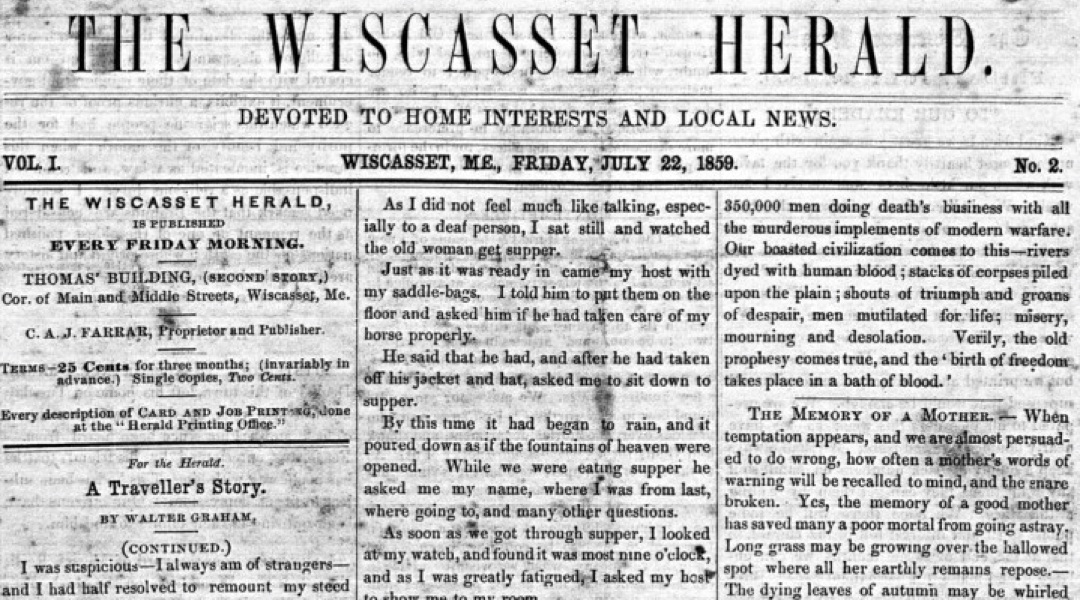
Charles A. J. Farrar was only 17 years old when he started this newspaper for young adults. While the paper survived only some four months, it provided Farrar valuable experience in writing, editing, printing, marketing, and distributing a written product –– skills he was to continue to sharpen and utilize throughout his adult life. Courtesy of Special Collections, Raymond H. Fogler Library, University of Maine, Orono.
In August of 1865, the 23-year-old Farrar married Rose Austin from Buckfield, Maine. Because many Farrars lived in Buckfield at the time, it’s likely that Charles met his wife-to-be while visiting Maine relatives. The couple was married in Boston and soon set up house-keeping in Jamaica Plains, southwest of downtown Boston. At the time, Jamaica Plain was a productive agricultural area growing food crops that were sold in Boston. The town had a railroad, offering Farrar a means to more easily distribute the products of his Jamaica Publishing Company, as well as to facilitate his travels north.
Farrar initially vacationed in northern New Hampshire, but in 1867 took his first vacation trip to the Rangeley Lakes. This region was to hold a life-long fascination for Farrar as he described some 23 years later when he was 46 years old: “I first visited it [the Rangeley Lakes region] when I was a young man, several years before I was at all interested in business, and some of the happiest hours of my life have been passed at the lakes, and I love the country. Those romantic sheets of water, whose ripples kiss the base of the grand old mountains by which they are surrounded, will ever hold a loving place in the warmest corners of my heart, and they will be visited by thousands for their pure air and fine scenery . . .” In 1872, while travelling over the Rangeley Lakes, Farrar met Fred C. Barker. At the time, Barker was camping at the old Richardson Farm on the Richardson Lakes. According to Barker, Farrar asked him to go into a partnership and form a transportation company to facilitate travel and tourism on, and around, the Rangeley Lakes. Barker declined, fearing that Farrar’s plan to borrow money to build a transportation company was too risky. Years later, Barker went on to develop his own system of steamboats and three hotels on Mooselookmeguntic Lake.

Capt. Charles A. J. Farrar’s business strategy was to control as much assess as possible into the Rangeley Lakes via the Lower Route through Bethel and Upton, Maine; and by the Middle Route through Andover, Maine. To capitalize on the traffic through these two points of access he owned and operated the Lakeview Cottage, shown above, on the South Arm of Lower Richardson Lake, as well as the Lakeside Hotel near Upton. Note the angler to the left of the boat storage building, the returning bird hunter in the foreground, as well as the telegraph line than ran to Bryant Pond. Illustration from Farrar’s Androscoggin Lakes Guidebook. Courtesy of a private collector.
Barker’s lack of support notwithstanding, in 1876 Farrar commenced commercial steamboat runs on Upper and Lower Richardson lakes, west of Mooselookmeguntic Lake. A year later, the Maine Legislature granted Farrar and associates exclusive rights to operate on the Richardson Lakes, and in 1881 the Richardson–Rangeley Lakes Transportation Company (R–RLTC) was incorporated under Maine law. A second law was passed in 1882 granting Farrar and associates exclusive commercial use of the Richardson Lakes until 1888. In 1885, the R–RLTC was dissolved, being replaced by the Androscoggin Lakes Transportation Company (ALTC). In all, Farrar and his investors had exclusive rights for commercial transportation on the Upper and Lower Richardson lakes for more than a decade—1877 to 1888.
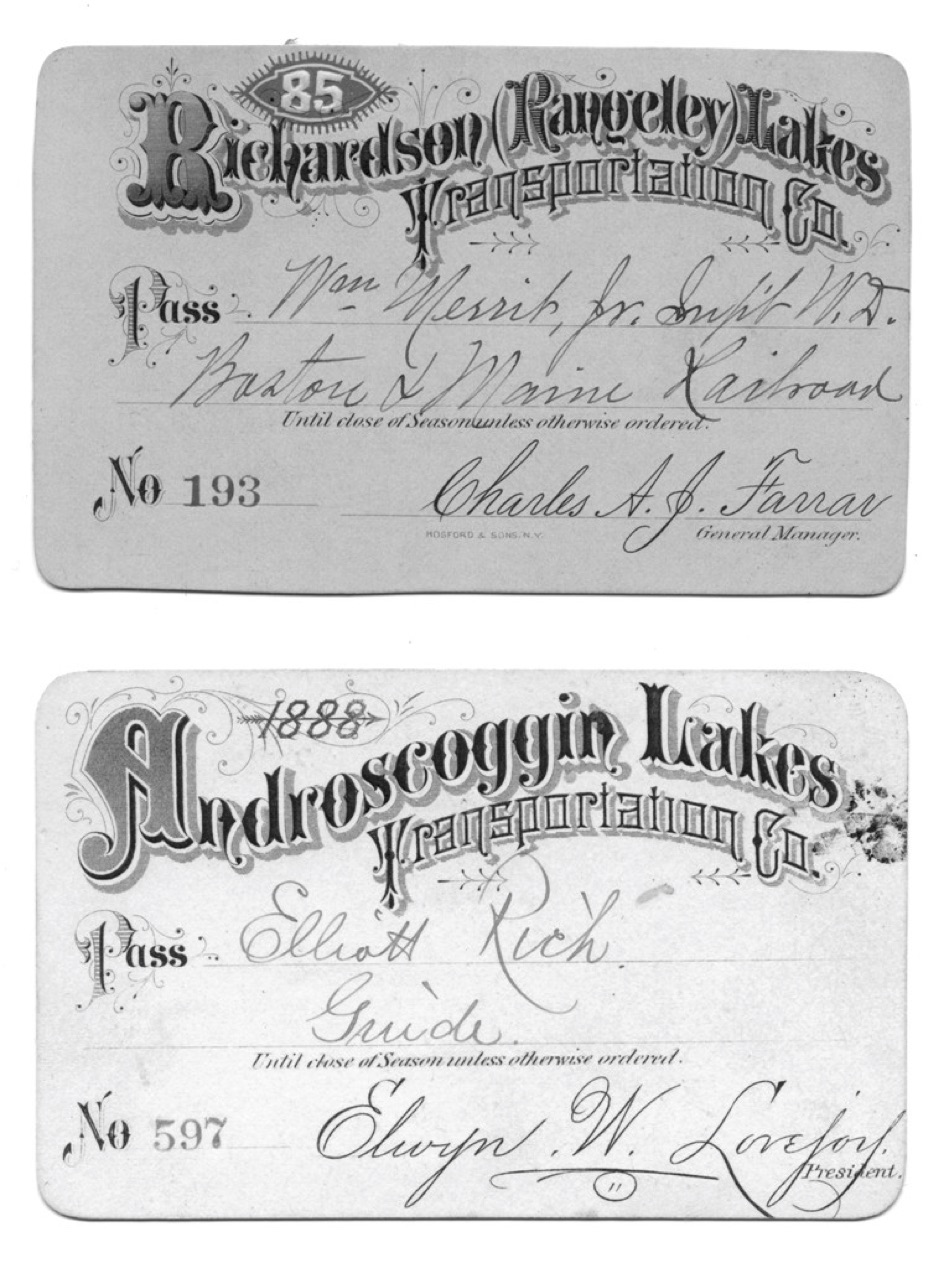
Cards used for free passage on the Richardson–Rangeley Lakes Transportation Company (upper illustration; company existed from 1881 to 1885) and the Androscoggin Lakes Transportation Company (lower; 1885 to 1900). Note that the upper pass is signed by Charles A. J. Farrar. This is one of the few samples known of his hand writing that have survived. The lower pass was issued to Elliot Rich, son of Joshua Gross Rich. Elliot and his wife worked for the Androscoggin Lakes Transportation Co., managing the Middle Dam Camp at the head of the Rapid River from 1889-90, and in 1891 managing the Lakeside Hotel over-looking the south end of Lake Umbagog. Courtesy of a private collector.
Farrar’s business plan was simple: concentrate and capitalize on the flow of people and goods into the lower Rangeley Lakes, specifically the Richardson Lakes, Lake Umbagog, the Rapid River which connected the two lakes, and the Magalloway River which flows into Lake Umbagog. Farrar’s legislated monopoly on commercial transportation over the Richardson Lakes (common during this period) provided him the certainty needed to attract investors. With adequate capital in-hand, he and his investors could move people and goods on land with horses, carriages, and wagons; and on water with a fleet of steamboats operating on the Richardson Lakes as well as Lake Umbagog and the lower Magalloway River. Additionally, they provided housing for the travelers in the lower Rangeley Lakes, leaving the upper Rangeley Lakes to others (e.g., Barker on Mooselookmeguntic Lake).
During this period there were three major routes to access the Rangeley chain of lakes: (1) the Upper Route via the town of Rangeley and Rangeley Lake, (2) the Middle Route via Andover and the South Arm of Lower Richardson Lake, and (3) the Lower Route via Bethel to Upton and Lake Umbagog. Farrar and associates built Lakeview Cottage on the South Arm to control the Middle Route, and owned and operated Lakeside Hotel above the southwest end of Lake Umbagog to control access to the Lower Route. Later, Farrar leased the Middle Dam Camp, thus controlling the waterway that linked Lower Richardson Lake and Lake Umbagog. Most of Barker’s clients, in contrast, came via the Upper Route.
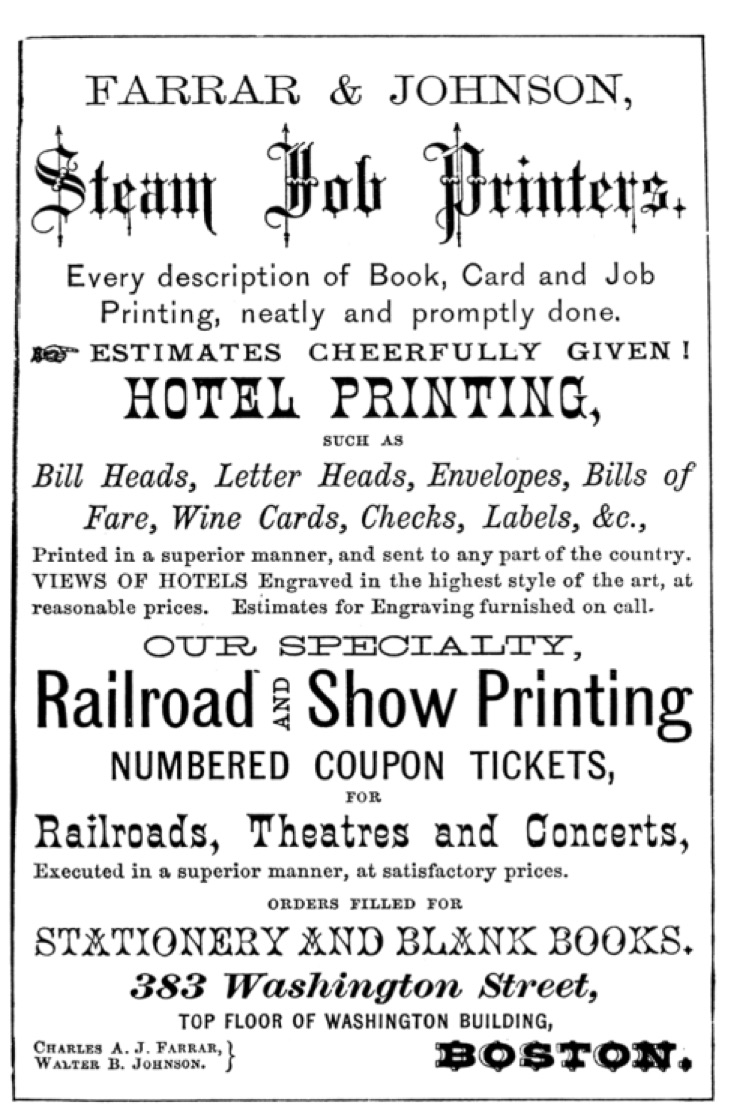
Farrar, in early adulthood, trained to become a printer. The above advertisement was the first page from Farrar’s first edition of his Rangeley Lakes guidebook, published by Farrar and Johnson Printers. Farrar used his skills as a printer to create and publish books, maps, and photographs that promoted adventures in the Maine woods, especially in the Rangeley Lakes Region. Courtesy of a private collector.
While Farrar had a clear business strategy in mind, he still faced the practical issue of how to attract an adequate supply of customers to pay for his extensive infrastructure. To solve this problem, Farrar relied on his literary and printing skills. In 1876, he wrote a factual guidebook to the Rangeley Lakes: Farrar’s Illustrated Guide Book to Rangeley, Richardson, Kennebago, Umbagog, and Parmarchenee Lakes, the Head-waters of the Connecticut, Dixville Notch, and Andover, ME., and Vicinity. This book described the services available to travelers that were located along the three major routes to access the Rangeleys. Two years later, he authored a similar book for Moosehead Lake: Farrar’s Illustrated Guide Book to Moosehead Lake and Vicinity, the Wilds of Northern Maine, and the Head-waters of the Kennebec, Penobscot, and St. John Rivers. Between 1876 and 1892, the Rangeley Lakes Guide went through 12 editions, whereas the Moosehead Lake Guide went through 9 editions (1878 to 1889). By studying these guidebooks in chronological order, the reader can see what facilities were available to the regions’ visitors, who owned and managed these facilities, how and when the facilities were improved, distances and travel times between locations, costs associated with the different services, and other information of use to the traveler.
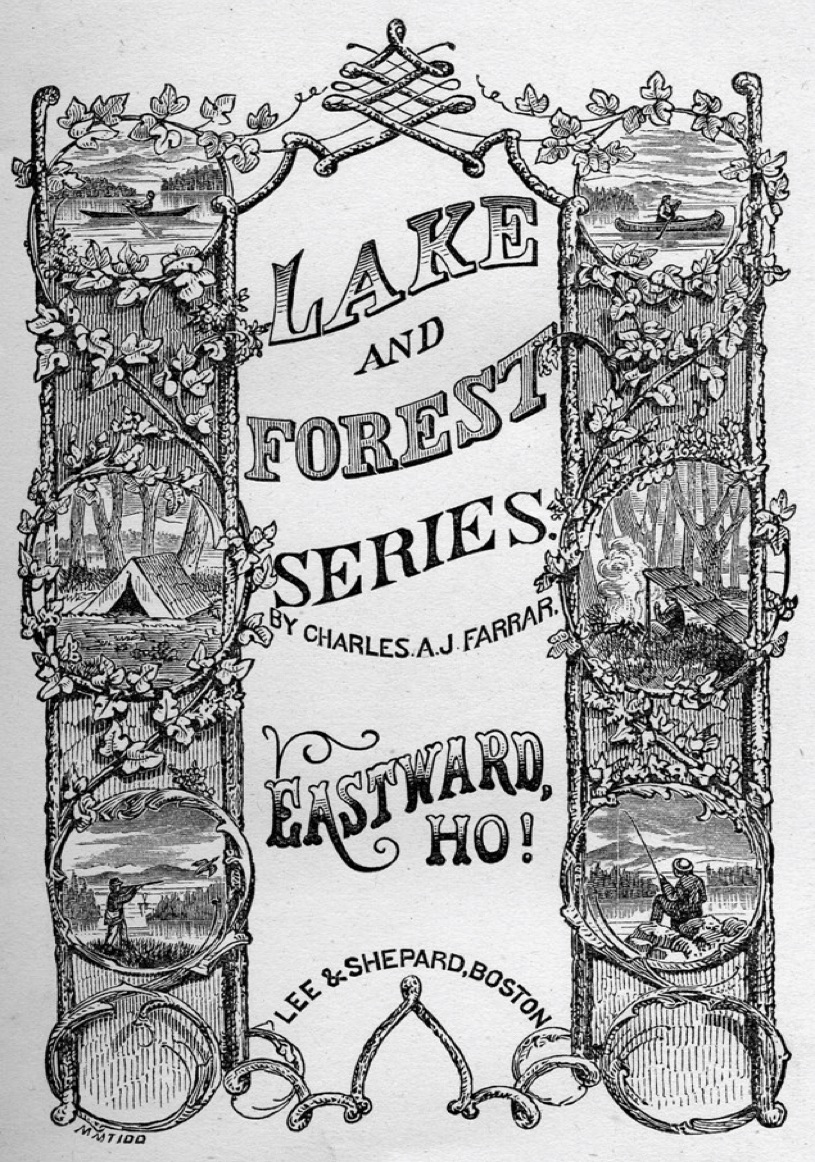
The four books in the Lake and Forest Series were primarily aimed at stirring the interest of young people to visit the wilds of Maine. The first two titles in this series were adventures that occurred in the Rangeley Lakes Region, and the latter two titles were about adventures taking place in the upper Penobscot River of Moosehead Lake country. Illustrations, such as the title page to the first title in this series shown above, enhanced Farrar’s primary message of “Come to the Maine woods and experience the adventure of a lifetime.” Courtesy of a private collector.
The text and advertisements in Farrar’s guidebooks are a useful source of primary historical information. Farrar’s guidebooks are exceptionally well illustrated with woodcuts. To ensure accurate illustrations , on at least one occasion Farrar hired a photographer to accompany him into the wilds of Maine. Later, these photographs were turned into stereoviews (which Farrar called “stereoscoptic views”) and cabinet photographs. While somewhat difficult to find today, these photographs provide a visual record of life in western Maine during the later 1800s.
In addition to being exceptionally well illustrated, Farrar’s guidebooks—as was customary for guidebooks to the Maine woods for this period—were often issued with detailed maps of the region covered in the guide. Farrar went even further with his maps (as did other guidebook authors), issuing stand-alone maps for the Rangeley Lakes, Moosehead Lake, and Dead River regions. One version of these maps had hard covers and was designed to be carried into the woods in a pocket as an easy-to-use reference.
In addition to fact-based guidebooks, and high quality maps and photographs, Farrar labored to capture the imagination of potential travelers by writing semi-factual and even fictional travel adventures. These books were aimed at the younger reader. His two semi-guidebooks were based on real incidents in his life, with the liberal addition of details to enhance the narrative. The two titles under this category were Camp Life in the Wilderness – A Tale of Richardson Lakes (published in 1879, 1882, 1890, and 1892) and From Lake to Lake, or A Trip Across Country (published in 1887, 1889, and 1890). Like his guidebooks, these books can be found in both soft and hard covers. Farrar’s juvenile fiction was published in what was called the Lake and Forest Series. The titles in the series were as follows: Eastward Ho, or Adventures at Rangeley Lakes (printed in 1880, 1884, 1887, and 1889); Wild Woods Life, or, A Trip to Parmarchenee (1884, 1889, 1897, and 1902); Down the West Branch; or, Camps and Tramps Around Katahdin (1885, 1886, 1889, and 1898); and Up the North Branch; A Summer’s Outing (1888, 1889, and 1897).
Farrar claimed that “This series of books is having a phenomenal sale, several editions of each volume having already been issued. The books are as great favorites with old people as with young, and have also met with a hearty reception from the gentle sex.” Given the number of times the above titles were printed, and the length of time the titles were kept available to the public, it’s obvious that Farrar’s Lake and Forest books sold exceptionally well.
Farrar’s life was not without incident. In August 1866, the Boston lawyer who was Farrar’s major partner in the R–RLTC was arrested for embezzlement. Throughout the summer and fall this scandal appeared on the front pages of the major newspapers in Boston and New York City. While the story died out when the lawyer was sentenced to “serve four years and three months at hard labor, with one day’s solitary confinement,” the incident continued to weigh heavily on Farrar.
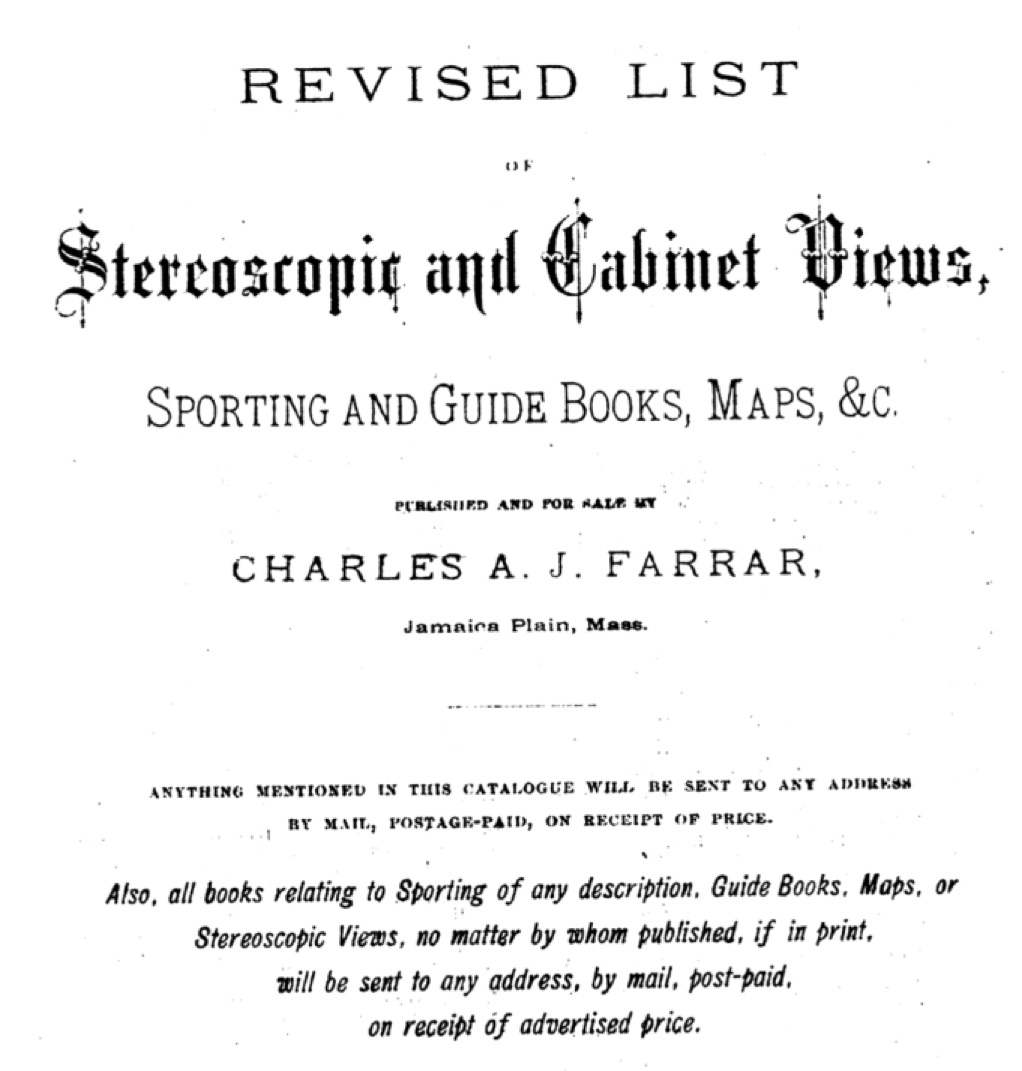
Capt. Charles A. J. Farrar created and distributed via mail products to help the eighteenth century adventurers visit and explore the wilds of western Maine. Shown here is a list of the 108 stereoviews, 9 cabinet photographs, and dozens of books authored by Farrar and others that he offered for sale. Farrar’s large and varied legacy of published materials provides today’s readers with information about western Maine that can be found nowhere else. Courtesy of the Special Collections, Raymond H. Fogler Library, University of Maine, Orono.
Not to be stopped by adversity, Farrar continued to improve his transportation company. In September 1892 he announced that he was supervising construction of his sixth steamboat. This steamboat was to be 75 feet long and 17 feet across; this would be Farrar’s largest boat. Named the “Capt. Farrar,” it had two steam engines and twin screws, and was designed to carry two hundred passengers. In Farrar’s words, this steamer “Will be finished in the best style both inside and out, and will be the largest and most comfortable boat in the whole [Rangeley] lake region and probably the fastest.” This same year, at age 50, Farrar launched yet another publishing project: The Sportsman and Tourist. This weekly ran from February 1891 until at least October 1892. With Farrar as editor and primary author, this periodical carried mostly articles about travel in the Rangeley Lakes Region, but also had articles from other areas, ranging from Florida to New Brunswick, Canada. The same year that Farrar launched The Sportsman and Tourist, his last book was published; Through the Wilds; a Record of Sport and Adventure in the Forests of New Hampshire and Maine was issued by Estes and Lauriat in Boston. It cost him nearly $10,000 to produce and contained 415 pages with over 300 woodcuts and photographs. Through the Wilds was the capstone to Farrar’s publishing career.

Of the dozens of products produced by Capt. Charles A. J. Farrar to promote tourism in western Maine during the late 1800s, perhaps none symbolize his core message than the above illustration. This graphic was used on the hard copy editions from the late 1880s of his book Farrar’s Illustrated Guide Book to Rangeley, Richardson, Kennebago, Umbagog, and Parmarchenee Lakes. Courtesy of a private collector.
This period of Farrar’s life was a time of both tragedy as well as triumph. In August 1891, his beloved wife died. She was only in her 52nd year. Through their years together the couple had grown close. The couple did not have any children, and she often travelled with her husband. Farrar dedicated Up the North the Branch to her (many of his books were dedicated to family and friends), writing, “To my wife, Rose Austin Farrar, whose faith and interest in my success have encouraged me to persevere against many difficulties in literary work.” In an obituary about his wife, Farrar wrote: “With malice toward none and charity for all, her life could not help being beautiful; and of her it could be truly said that all who knew her loved her. Very few people had a larger circle of friends, for, with her bright, sunny disposition and kindly feelings towards all, it could not be otherwise.” Of his own situation, Farrar goes on in the obituary to reveal that “Within ten years the editor has lost mother, brother, and wife, and is now alone, the last of his family; but in his loneliness he has the satisfaction of knowing that everything that a loving husband could do for a dear wife he did for Mrs. Farrar, and the kind words of sympathy and respect, and the touching letters from dear friends now away on their summer outings, are additional consolation in his hour of greatest sorrow.”
In January 1893, one year and five months after his Rose’s passing, Charles A. J. Farrar died at his Jamaica Plain home. He was 51 years old. Seven years after Farrar’s death, the steamboat “Capt. Farrar” was hauled up on an island and burnt. So ended the lives of a prolific writer and his transportation company. But what of Farrar’s legacy?
Fifteen years after Farrar’s death, his long-time competitor in the hotel and transportation business, Capt. Fred C. Barker, wrote in the Phillips Phonograph, “He [Farrar] wrote up the region and interested the transportation companies in its possibilities and although in many respects he may not have been the man for the place and made many mistakes, no one played harder luck . . . He followed [after his wife’s death] a little later after a few years of broken health, wasted energies, and an unsatisfactory and unprofitable business experience.” Other assessments of Farrar’s accomplishments by his contemporaries were not as harsh as Barker’s. For example, shortly after Farrar’s death, Boston newspaper man William K. Moody wrote an obituary appearing in Forest and Stream, declaring that “Capt. Farrar has done more to make the Rangeley Lakes famous than any other man. . . . The railway and hotel interests of Maine owe to Capt. Farrar a debt of gratitude, and yet in his lifetime the debt was hardly more than grudgingly acknowledged.” A more recent assessment of Farrar that appeared in Angling Books of the Americas (1975), authored by Henry P. Burns, was also positive: “All of Farrrar’s works are fascinating Americana, with detailed information about an almost untouched wilderness, not primitive, or savage, merely unused. The pages of advertising are historically informative and historically important. Full of angling, the books are important to the collector, but he must compete with the collector of all Americana. All Farrar works are scarce to very scarce.”
Capt. Charles A. J. Farrar was an actor, author, editor, printer, and publisher. He was also a steamboat owner and operator—an entrepreneur and manager of a complex, integrated transportation business. As a person, Farrar was an attention getter, out-going, ambitious and hard-working, meticulous, and always the optimistic romantic. He was at times unrealistic, a risk taker who both succeeded and failed. Despite a relatively short life, Farrar was a prolific writer producing a wide variety of printed works. Always the promoter, his fictional and semi-fictional books should be viewed skeptically by the historical reader, but with careful scrutiny Farrar’s works provide many insights into nineteenth century life in western Maine. His guidebooks, periodicals, maps, and photographs—in contrast—provide a wealth of primary facts deserving serious study. But whether fact or fiction, the underlying theme in all of Farrar’s works was simple: “Come to western Maine and experience the adventure of a lifetime.” Not bluntly stated, but still present was his secondary message: “And I have the physical means to get you into the wilds of Maine and back out.”
In conclusion, we should remember Charles A. J. Farrar as an early, effective, and innovative promoter of tourism in western Maine (and beyond). While Farrar’s work was a little earlier than that of Fly Rod Crosby, and while focused on a different area (he on the lower Rangeley Lakes, she on the upper Rangeleys), the depth and breadth of the many documents he left behind both tell and show the story of what life was like in western Maine during the late 1800s. Because of a record of significant accomplishments, Charles A. J. Farrar is just as deserving of recognition as is Cornelia T. Crosby, although by no means is Farrar the last of the early promoters of Maine tourism still to be rediscovered (e.g., consider George H. Haynes).
